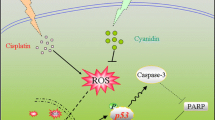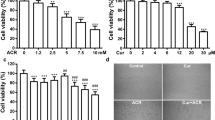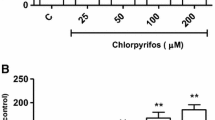Abstract
Objective
Curcumin is extracted from the turmeric plant (Curcuma longa Linn.) and is widely used as a food additive and traditional medicine. The present study investigated the activity of curcumin against staurosporine (STS) toxicity in cell culture.
Methods
Rat hippocampal neurons in primary culture were exposed to STS (20 μmol/L) and treated with curcumin (20 μmol/L). Cell viability was tested by MTT assay and reactive oxygen species (ROS) were measured using the MitoSOX™ red mitochondrial superoxide indicator. Western blot was used to assess changes in the levels of caspase-3 (Csp3), heat shock protein 70 (Hsp70) and Akt.
Results
The results showed that curcumin protects against STS-induced cytotoxicity in rat hippocampal neurons. Csp3, Hsp70, Akt and ROS activation may be involved in this protection.
Conclusion
Curcumin could be a potential drug for combination with STS in cancer treatment to reduce the unwanted cytotoxicity of STS.
Similar content being viewed by others
References
Omura S, Iwai Y, Hirano A, Nakagawa A, Awaya J, Tsuchya H, et al. A new alkaloid AM-2282 OF Streptomyces origin. Taxonomy, fermentation, isolation and preliminary characterization. J Antibiot (Tokyo) 1977, 30: 275–282.
Takahashi I, Asano K, Kawamoto I, Tamaoki T, Nakano H. UCN-01 and UCN-02, new selective inhibitors of protein kinase C. I. Screening, producing organism and fermentation. J Antibiot (Tokyo) 1989, 42: 564–570.
Tamaoki T, Nomoto H, Takahashi I, Kato Y, Morimoto M, Tomita F. Staurosporine, a potent inhibitor of phospholipid/Ca++dependent protein kinase. Biochem Biophys Res Commun 1986, 135: 397–402.
Gani OA, Engh RA. Protein kinase inhibition of clinically important staurosporine analogues. Nat Prod Rep 2010, 27: 489–498.
Ringman JM, Frautschy SA, Cole GM, Masterman DL, Cummings JL. A potential role of the curry spice curcumin in Alzheimer’s disease. Curr Alzheimer Res 2005, 2: 131–136.
Kim DS, Park SY, Kim JK. Curcuminoids from Curcuma longa L. (Zingiberaceae) that protect PC12 rat pheochromocytoma and normal human umbilical vein endothelial cells from betaA(1-42) insult. Neurosci Lett 2001, 303: 57–61.
Xu YX, Pindolia KR, Janakiraman N, Chapman RA, Gautam SC. Curcumin inhibits IL1 alpha and TNF-alpha induction of AP-1 and NF-kB DNA-binding activity in bone marrow stromal cells. Hematopathol Mol Hematol 1997, 11: 49–62.
Pan MH, Lin-Shiau SY, Lin JK. Comparative studies on the suppression of nitric oxide synthase by curcumin and its hydrogenated metabolites through down-regulation of IkappaB kinase and NFkappaB activation in macrophages. Biochem Pharmacol 2000, 60: 1665–1676.
Ono K, Hasegawa K, Naiki H, Yamada M. Curcumin has potent anti-amyloidogenic effects for Alzheimer’s beta-amyloid fibrils in vitro. J Neurosci Res 2004, 75: 742–750.
Qin XY, Cheng Y, Cui J, Zhang Y, Yu LC. Potential protection of curcumin against amyloid beta-induced toxicity on cultured rat prefrontal cortical neurons. Neurosci Lett 2009, 463: 158–161.
Calabrese V, Scapagnini G, Colombrita C, Ravagna A, Pennisi G, Giuffrida Stella AM, et al. Redox regulation of heat shock protein expression in aging and neurodegenerative disorders associated with oxidative stress: a nutritional approach. Amino Acids 2003, 25: 437–444.
Papasozomenos S, Shanavas A. Testosterone prevents the heat shock-induced overactivation of glycogen synthase kinase-3 beta but not of cyclin-dependent kinase 5 and c-Jun NH2-terminal kinase and concomitantly abolishes hyperphosphorylation of tau: implications for Alzheimer’s disease. Proc Natl Acad Sci U S A 2002, 99: 1140–1145.
Setalo G Jr, Singh M, Guan X, Toran-Allerand CD. Estradiolinduced phosphorylation of ERK1/2 in explants of the mouse cerebral cortex: the roles of heat shock protein 90 (Hsp90) and MEK2. J Neurobiol 2002, 50: 1–12.
Zamostiano R, Pinhasov A, Bassan M, Perl O, Steingart RA, Atlas R, et al. A femtomolar-acting neuroprotective peptide induces increased levels of heat shock protein 60 in rat cortical neurons: a potential neuroprotective mechanism. Neurosci Lett 1999, 264: 9–12.
Hill MM, Hemmings BA. Inhibition of protein kinase B/Akt. Implications for cancer therapy. Pharmacol Ther 2002; 93: 243–251.
Burugula B, Ganesh BS, Chintala SK. Curcumin attenuates staurosporine-mediated death of retinal ganglion cells. Invest Ophthalmol Vis Sci 2011, 52: 4263–4273.
Sharma RA, Gescher AJ, Steward WP. Curcumin: the story so far. Eur J Cancer 2005, 41: 1955–1968.
Chiu SS, Lui E, Majeed M, Vishwanatha JK, Ranjan AP, Maitra A, et al. Differential distribution of intravenous curcumin formulations in the rat brain. Anticancer Res 2011, 31: 907–911.
Frautschy SA, Hu W, Kim P, Miller SA, Chu T, Harris-White ME et al. Phenolic anti-inflammatory antioxidant reversal of Abetainduced cognitive deficits and neuropathology. Neurobiol Aging 2001, 22: 993–1005.
Li WP, Chan WY, Lai HW, Yew DT. Terminal dUTP nick end labeling (TUNEL) positive cells in the different regions of the brain in normal aging and Alzheimer patients. J Mol Neurosci 1997, 8: 75–82.
Gomez-Isla T, Hollister R, West H, Mui S, Growdon JH, Petersen RC, et al. Neuronal loss correlates with but exceeds neurofibrillary tangles in Alzheimer’s disease. Ann Neurol 1997, 41: 17–24.
Author information
Authors and Affiliations
Corresponding author
Additional information
These authors contributed equally to this work.
Rights and permissions
About this article
Cite this article
Qin, XY., Lv, JH., Cui, J. et al. Curcumin protects against staurosporine toxicity in rat neurons. Neurosci. Bull. 28, 606–610 (2012). https://doi.org/10.1007/s12264-012-1275-x
Received:
Accepted:
Published:
Issue Date:
DOI: https://doi.org/10.1007/s12264-012-1275-x




